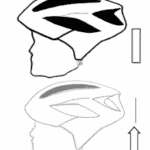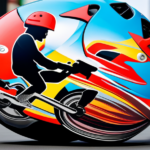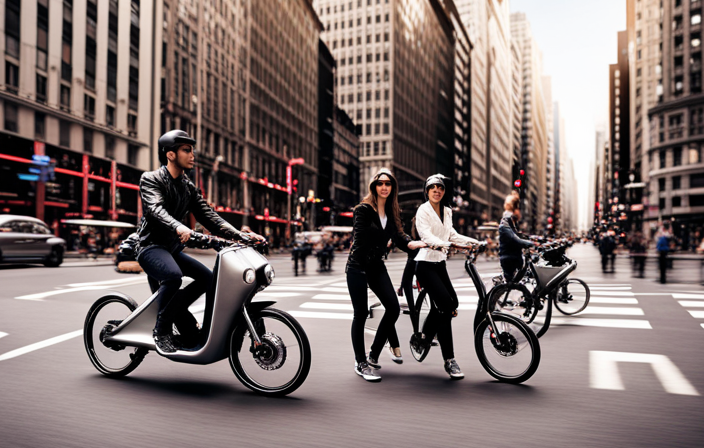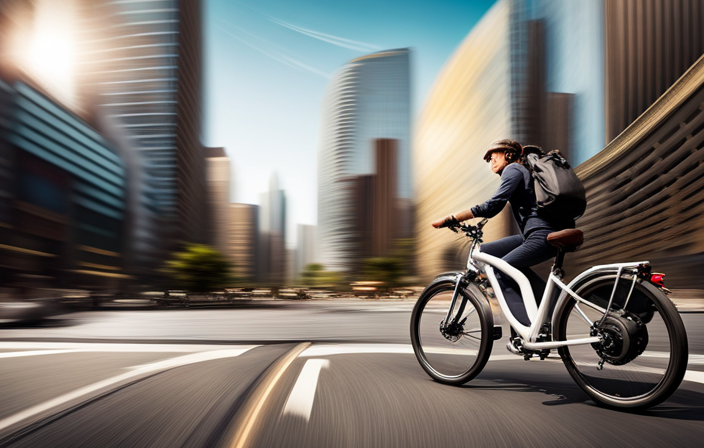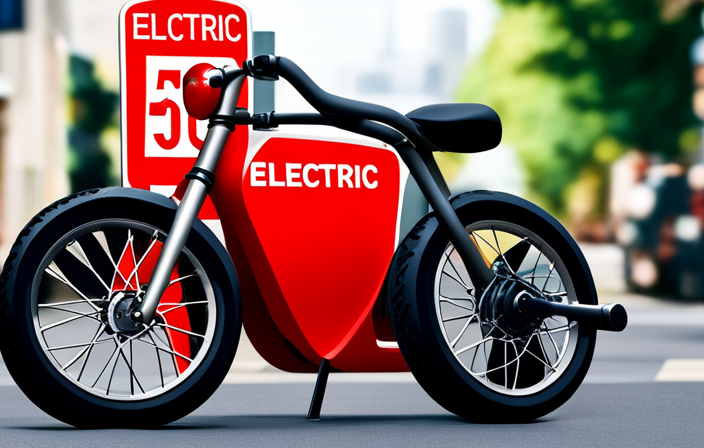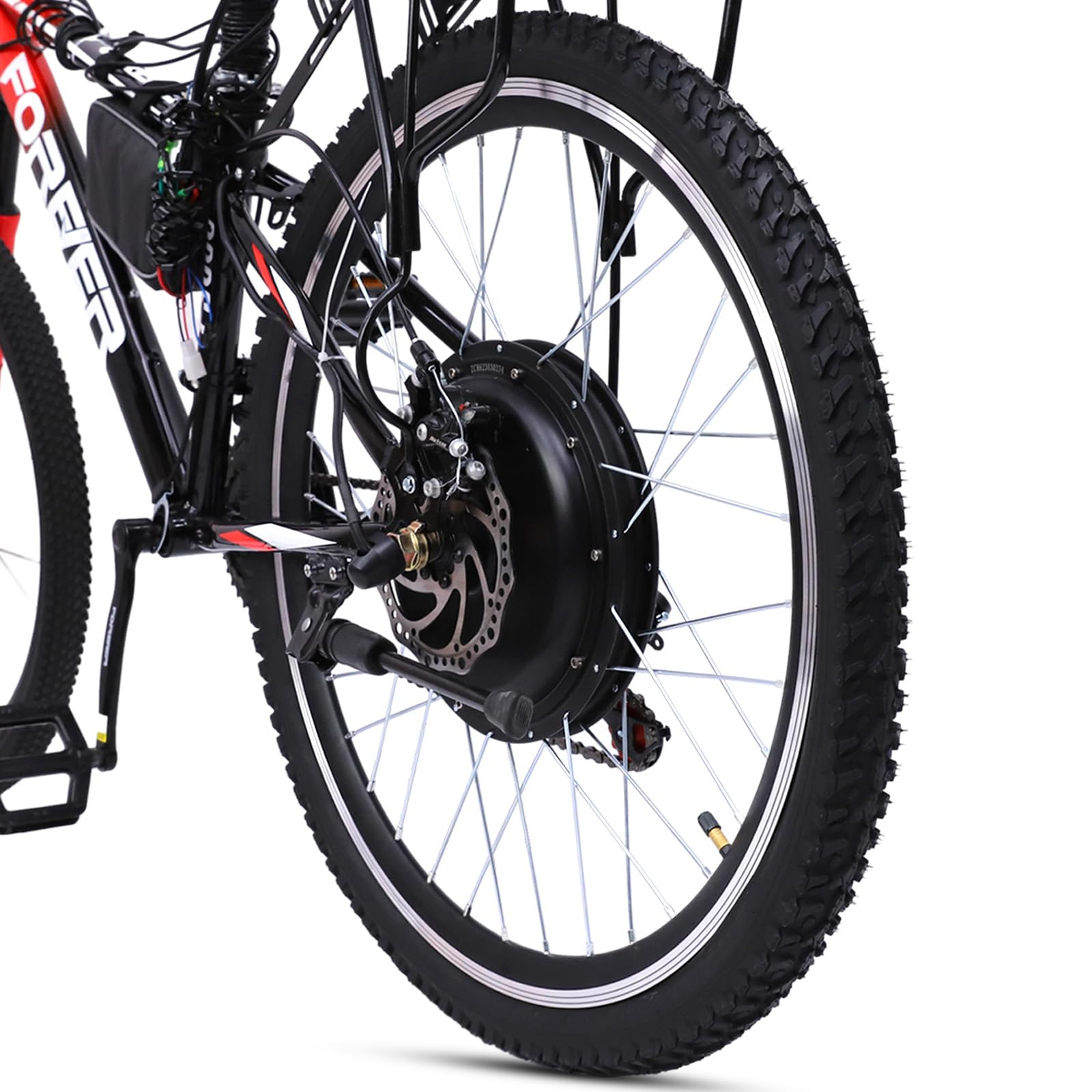Beginners Guides
How to Wear a Bike Helmet
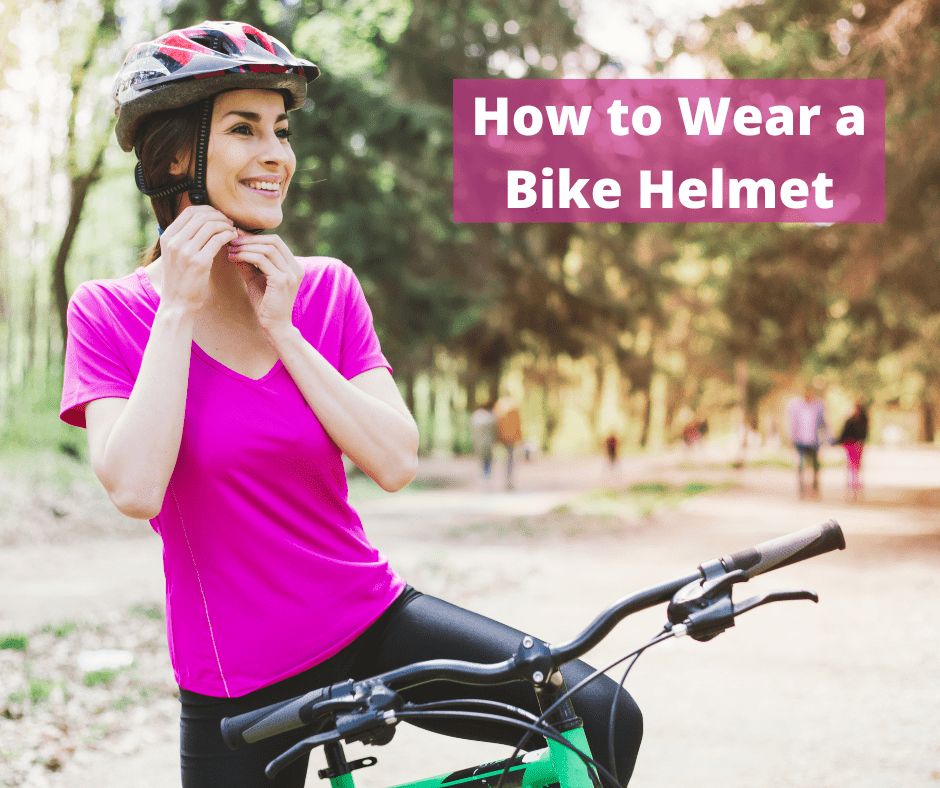
For a bicyclist, it’s crucial to wear the appropriate helmet to ensure your safety during your journeys.
In this article, I’ll be discussing the importance of wearing a bike helmet and how to make sure you’re wearing it correctly. A good bike helmet is designed to absorb the impact of any falls or collisions you may experience while cycling. Without one, you could suffer severe head injuries that could have easily been avoided with the right protection.
So let’s talk about how to wear a bike helmet properly so you can stay safe on your next ride!
Fitting a Bike Helmet
There are two basic ways of fitting a bike helmet. First, look in a mirror and move the helmet on your head. The straps should fit snugly and comfortably. Check that the chinstrap buckles fit well around your eyebrows. If they do not, you may need to adjust the straps. If you can’t figure out how to fit a bike helmet, you can follow the instructions in the helmet’s owner’s manual.
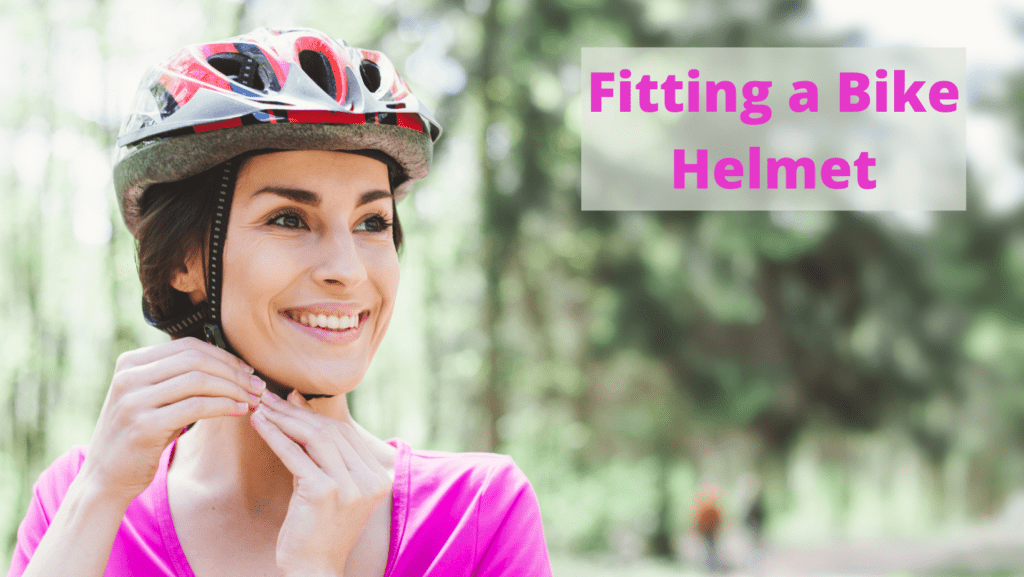
The second method is to loosen the straps. Depending on your head size, you may find the straps too tight, so try to reduce them. Similarly, you can adjust the side fit pads if your head is narrow. The padding should touch your head evenly on all sides. The pads should feel snug and not tight, and they will likely compress as they become looser over time. Finally, make sure the helmet is level on your head essential. The front edge of the helmet should be just above your eyebrows or the frame of your glasses.
Benefits Of Wearing A Bicycle Helmet
Back in the day, helmets were not a thing, so cyclists used to just take the good ol’ risk and ride their bikes without any head protection. But times have changed! Nowadays, wearing a bike helmet is a must for anyone who’s taking on two-wheeled adventures.
As a bike safety educator, I can’t stress enough how important it is to wear a helmet whenever you’re cycling.

A bicycle helmet is designed with an outer shell and inner foam liner that helps to absorb shocks from impacts and collisions. Wearing a bike helmet is the best way to protect your head from serious injury or even death in case of an accident while cycling. It also provides protection against the sun and bugs – both of which can be quite annoying on those long rides!
Bike helmets come in all shapes and sizes, so it’s important to determine the right size for you before making your purchase. Comfort is key when it comes to using your bike helmet properly – if your helmet doesn’t feel right, you’re less likely to wear it every time you ride.
So let’s take a look at some tips on how to determine the right size bike helmet for you!
Determining The Right Size
When it comes to wearing a bike helmet correctly, size is key. To ensure you have the right fit, measure the circumference of your head with a soft tape measure positioned just above your eyebrows. You should get an accurate reading that corresponds with sizes typically available in helmets.
When selecting a helmet, try it on and make sure it sits squarely on your head without wobbling or tilting. The chin strap should be snug enough so that when you open your mouth wide, you feel the helmet press against the top of your head. There should only be room for two fingers between the strap and your chin, no more!

Now that you know what size helmet to get, it’s time to learn how to fit it properly. It’s important to make sure the helmet is secure and comfortable before every ride – nothing should be obstructing your vision and hearing while biking.
Adjust both side straps evenly until they form a ‘V’ shape just below and slightly in front of your ears. Make sure that the buckle clip is easy to fasten so you can take off or put on your helmet quickly if needed.
The next step is crucial – tighten the band until it fits snugly around your head but still allows two fingers between the straps and chin for comfort.
Bike helmets are designed to keep us safe while we ride, but only if they fit correctly! Follow these simple steps for determining the right size and fitting a helmet properly so that you can stay safe out there!
How To Fit A Helmet Properly
When it comes to bike safety, one of the most important elements is wearing a helmet. After all, the right helmet can mean the difference between life and death. But how do you put on a bike helmet safely?
Fitting a helmet properly is essential for optimal protection. To get started, make sure you have a helmet that fits your head correctly. Measure your head circumference and find a helmet that is the right size. The helmet should sit snugly on your head – not too tight or too loose – and shouldn’t move around when you shake your head.

When it’s on correctly, here are 4 key things to check:
- Make sure the straps form a ‘V’ shape just below your ears
- Adjust the buckle so it sits just below your chin
- Make sure both straps are tightened equally
- Ensure there is no gap between the strap and your skin
Once you’ve ensured the helmet fits correctly, you can go out and enjoy cycling with confidence!
Different Types Of Helmets
Now that you’ve learned the basics of fitting a helmet properly, let’s discuss different types of helmets.
There are several types of helmets available for cyclists, and it is important to select one appropriate for your activity.
It is generally advised to choose a helmet that fits snugly and is the correct size.
Different helmets have different features and parts, such as an outer shell designed to absorb impacts in case of a crash.
Helmets vary in design according to the type of cycling they are meant for.
A road bike helmet might be lightweight and aerodynamic, while a mountain bike helmet might offer more protection with its visor and extended coverage around the sides and back.
If you ride regularly on both roads and trails, consider getting two different helmets with the features best suited for both activities.
Additionally, it may be helpful to consider what else is needed when selecting a helmet: some helmets come with built-in visors or attachable mirrors, while others offer additional safety features like integrated lights or reflective materials.
Once you have chosen your helmet, it’s important to know how to take care of it correctly so it can provide adequate protection over time.
Correct Helmet Care
When it comes to bike helmet fit, it’s essential to make sure your helmet fits your head correctly. Helmets are designed to be snug, yet comfortable on the head. To ensure a proper fit, adjust the straps and tighten them until they fit snugly around the head. If you have difficulty making adjustments, consult with an expert who can help you with ensuring the correct size and fit of your bike helmet.
It’s important to take proper care of your helmet in order to maximize its lifespan, and ensure that it provides optimal protection for your head. Cleaning your bike helmet regularly is important for keeping it in good condition. Use mild soap and water when cleaning your helmet, but avoid using any harsh detergents or abrasive tools that could damage the outer shell.

Additionally, be sure to inspect your bike helmet often for any signs of wear and tear or damage that may need to be repaired or replaced. To protect your investment in a quality bicycle helmet, always store it in a cool dry place when not in use. Excessive heat, cold temperatures, and humidity can all cause damage to the materials used in helmets and reduce their effectiveness over time.
With proper care, you can rest assured that your helmet will provide maximum protection during every ride!
How To Wear A Bicycle Helmet
Every cyclist should understand the importance of wearing a bicycle helmet — it’s the best way to protect yourself from serious head injury.
As a bike safety educator, I’m here to tell you that wearing a bike helmet isn’t just about safety, it’s also about comfort and making sure your helmet fits correctly.
Choosing the right helmet is critical: it should fit snugly on your head and not move when you shake your head or turn quickly.
The straps should be adjustable so you can get a secure fit, and the chin strap should fit firmly under your chin.
It’s important that the helmet sits level on your head — not tilted back or forward — so that it provides full protection in case of an accident.
Bike helmets are designed to absorb shock if you fall off your bike, but only if they’re worn properly.
This means ensuring the straps are adjusted so that the helmet fits securely on your head and doesn’t move around when you ride.
By following these simple tips, you can make sure your helmet fits correctly and provide maximum protection for your noggin!
With this knowledge, you’re ready for the next step: ensuring proper wear of your bike helmet whenever you hit the road.
Ensuring Proper Wear
When wearing a bike helmet it is essential to ensure that it fits properly. To do this, you need to adjust the straps and tighten the helmet so that it fits snugly on your head. The helmet should fit level on your head, meaning that it won’t tilt back or forward when worn correctly.
Ensure the circumference of your head is measured correctly before buying a helmet; if the helmet sits too low or too high then you will need to adjust the size accordingly.
When adjusting the straps, make sure not to pull them too tightly as this can be uncomfortable. Instead, adjust in small increments until you find a comfortable but secure fit. It’s important to ensure that the straps are adjusted correctly so that the helmet doesn’t move around when riding and also for greater comfort.

Now that you know how to wear a bike helmet correctly, it’s time to think about replacing an old or damaged one.
Old helmets may not provide adequate protection and can become brittle after years of use and exposure to sunlight. Investing in a new bike helmet will help protect you while riding and provide peace of mind knowing that your head is safe while cycling on roads or trails.
Replacing An Old Or Damaged Helmet
When selecting a bike helmet, it is important to ensure that it fits properly. Wearing the wrong size helmet can not only be uncomfortable but also dangerous as it won’t protect your head in case of an accident.
A good way to determine the correct size is by measuring your head circumference and comparing it with the sizes available for purchase. To measure your head, use a tape measure and place it around your head about two finger-widths above your eyebrows. Once you have your measurement, look for a helmet that corresponds to the right size according to the manufacturer’s guidelines.

If you already have an old or damaged helmet, then you should consider replacing it with a new one as soon as possible. While helmets are designed to protect against impacts, they do not last forever and may lose their protective properties over time due to wear and tear.
It is best to replace an old or damaged helmet so that riders are always safe while out on their bike rides.
With these tips in mind, it’s time to choose the right helmet for you!
Choosing The Right Helmet
Choosing the right helmet is really important to ensure your safety.
Start by making sure the size and fit are correct; your helmet should feel comfortable and secure when you put it on.
Then, consider the ventilation and comfort the helmet offers; it should be well-ventilated to keep you cool and comfortable.
Finally, make sure the helmet you select meets safety standards; it should have a sticker certifying that it meets safety regulations.
I’m here to help you pick the right helmet so you can ride safely!
Size And Fit
Finding the right size and fit for your bike helmet is key to getting the most out of your bike ride. As a bike safety educator, I’m here to tell you that it’s important to take a few minutes to make sure you have the best fitting helmet for your head.
To start, grab a tape measure and wrap it around your head about 1 inch above your eyebrows. This will provide you with the circumference of your head so that you can choose the size of helmet that fits best.
Next, try on different sizes and shake your head from side to side and up and down – if the helmet moves more than an inch in any direction, it’s too large.
Finally, adjust the straps dividers underneath your chin to ensure a snug fit when you buckle up – not too tight, but snug enough so that the helmet doesn’t move when you move your head.
Once you’ve found a comfortable size and fit, all that’s left is to get out there and have an awesome ride!
Ventilation And Comfort
Now that you’ve found the right size and fit for your bike helmet, it’s time to consider ventilation and comfort.
As a bike safety educator, I want to make sure you have all the information you need when choosing the best helmet for your ride.
Many helmet models offer a great fit system with additional padding for an even more comfortable experience, so try on several different models until you find one that fits just right.
Make sure to wear your helmet over a ponytail or any other hairstyle, and be sure to adjust the strap dividers underneath your chin as needed.
That way, you’ll be able to stay cool and comfortable while enjoying every minute of your ride!
Safety Standards
Now that you know how to properly adjust the fit of your helmet, it’s time to talk about safety standards.
The most important thing when riding is making sure you have the right size bike helmet and that you wear it properly.
Your helmet must meet certain safety standards in order for it to be effective.
It should have a CPSC (Consumer Product Safety Commission) sticker on it to show that it meets all the necessary requirements for you to ride safely.
The CPSC sets standards for impact protection and other areas, so make sure your helmet meets those standards before you go out for a ride!
Additionally, look for additional certifications from organizations like ASTM (American Society for Testing and Materials) and Snell (Snell Memorial Foundation).
This will ensure your helmet is up-to-date with current safety standards and provide extra assurance that your head is well protected.
Safety Standards For Helmets
Once you have chosen the right helmet for your biking needs, it is important to make sure it fits correctly.
A bike helmet should sit level on your head and not tilt back or forward. To ensure a secure fit, tighten the chin strap so that it fits snugly under your chin. You can also adjust your helmet by using the dial or wheel on the back of the helmet to make sure it fits snugly around your head.
It is essential that a bike helmet fits properly in order to be effective in protecting riders from head injuries. Your helmet should fit snugly and securely without moving around too much when you move or shake your head. If you can fit several fingers between your forehead and the front edge of the helmet, then it is too loose and needs adjusting.
It is always important to educate yourself about safety standards for helmets before purchasing one, as well as how to wear a bike helmet correctly so it will protect you while cycling. By following these easy steps, you can ensure that you are taking all necessary precautions when riding a bicycle!
Now let’s discuss some tips for keeping children safe while biking.
Keeping Children Safe
As a bike safety educator, one of the most important things I emphasize is making sure children are wearing their helmets correctly.
A helmet must be on your head so that it covers your forehead and is level across the front. The helmet should never move more than an inch in any direction when the straps are adjusted. It’s important to check that the straps are snug but comfortable and that the buckle is securely fastened.
When purchasing a new helmet, make sure you choose one that fits properly and meets current safety standards. Ensure it’s not too big or too small for your child’s head, and select one with adjustable straps and pads for a comfortable fit. Additionally, check that there are no signs of wear or damage and replace any worn-out helmets immediately.
It’s also essential to ensure your child understands how to properly wear their helmet each time they ride a bike. Teach them to position the helmet on their head before doing up the chin strap, positioning the front of the helmet low over their eyebrows—not covering their eyes—and then tightening each strap so that it sits comfortably around their ears.
Wearing a helmet correctly can help reduce serious injuries in an accident; however, it’s best to avoid accidents altogether! To move on into our next topic about special helmets for different activities, let’s take a look at what types of helmets may be best suited for certain activities.
Special Helmets For Different Activities
When it comes to bike safety, the helmet is arguably the most important piece of gear. It’s important to find a helmet that fits properly and is specifically designed for the type of biking you do.
To fit a bike helmet correctly, begin by measuring the circumference of your head with a flexible tape measure about 1 inch above your eyebrows. Tighten the strap so it fits snugly around your head and buckle the chinstrap under your chin. The correct fit should allow two fingers to fit between the strap and your chin and hug your head evenly all around without tilting back or forward. Your forehead should be exposed when wearing the helmet correctly.
It’s also important to consider special helmets for different activities, such as mountain biking or BMX biking.
Different helmets are designed for different sports and provide additional features that make them better suited for specific activities:
- Mountain bike helmets often include a visor at the front of the helmet to protect against sun glare, branches and debris while riding through forests or down hills.
- BMX helmets have more coverage over the back and sides of your head for increased protection from impacts during tricks or stunts.
- Road bike helmets offer light weight construction that helps reduce drag on fast rides along flat terrain.
A bike helmet should always fit properly in order to provide adequate protection in case of an accident or fall.
What To Wear Under A Helmet
When it comes to what to wear under a helmet, there are a variety of options such as a headband, moisture-wicking fabric, sweatband, scarf, beanie, balaclava, bandana, hat, skull cap, helmet liner, helmet cover, baseball cap, head wrap, hair band, and headgear.
I recommend using something that is lightweight and comfortable, like a sweatband or a headband, so you can stay cool and dry while biking.
For colder temperatures, you’ll want something that provides insulation like a balaclava, beanie, or a helmet liner.
Whatever you choose, make sure it fits properly and is securely fastened, so you can stay safe on your bike ride.
Headband
It’s important to make sure your head is comfortable and protected when you’re wearing a bike helmet.
Wearing a thin headband underneath the helmet can help improve the fit of the helmet and keep it level on your head.
Make sure to adjust the straps at the back and sides of the helmet so that it’s snug, but not too tight.
You should be able to fit two fingers between your chin and the chin strap, so you know it’s tightened enough while still being comfortable.
A thin headband can also reduce sweating and make wearing a bike helmet more enjoyable overall.
All of these small adjustments add up to help ensure that you stay safe while biking.
Moisture-Wicking Fabric
When it comes to wearing a bike helmet, comfort is key.
Wearing a thin headband underneath the helmet will help keep the helmet level on your head and improve the fit.
But if you want to stay even more comfortable while wearing one, opting for a moisture-wicking fabric is a great option.
Not only will this fabric help keep your head cool and dry, but it also helps ensure that your helmet fits correctly and stays in place when you adjust the straps.
This way you can be sure that all of these small adjustments are making an impact on your safety while biking.
Motorcycle Helmets
Using a helmet is the single most important step you can take to protect yourself while riding a bicycle. A properly-fitted helmet should fit snugly and stay in place during normal riding conditions. It shouldn’t move or shift when you shake your head.
Below is an easy guide to ensure your helmet fits correctly:
Step Details Measure your head size Use a flexible tape measure around the circumference of your head, just above your ears and eyebrows. This will give you an accurate measurement of the size of your head. Choose the right type of helmet Depending on your activity, choose a helmet that meets the standards for that activity (i.e., bike helmets, skateboarding helmets). Different activities require different levels of protection and fit. Adjust the straps Make sure the straps are tight enough so they don’t move or slide off when you shake your head. The straps should form a “V” shape under each ear when buckled correctly and should be snug but not too tight.
It is essential to wear a well-fitted helmet as it helps reduce the risk of serious injury in case of an accident or fall. It’s also important to inspect your helmet regularly for any signs of damage or wear and tear to ensure it provides maximum protection when you ride. With these tips, you can be confident that you will have the correct fit and be able to enjoy biking with peace of mind! Next we’ll discuss ways to encourage others to wear helmets too.
Encouraging Helmet Use
Are you ready to become a helmet guru? Well, strap on your helmet and let’s get started!
First things first: making sure your helmet is tilted back correctly. Yes, I know this may sound obvious, but trust me when I say that many riders forget this simple step. You want to make sure the front of your helmet is back far enough so that it almost looks like it’s not even there. That way, you know it fits properly and won’t move around when you’re riding.
If your helmet isn’t positioned correctly, don’t be afraid to adjust it! Just reach up with both hands and push the helmet down until it fits snugly above your forehead.
Then, turn your head from side to side and make sure the padding inside the helmet moves with you as you move. This will ensure that your helmet is secure and comfortable for a safe ride every time.
So remember: tilt the front of the helmet back, take time to make sure it fits properly, and then push the helmet down until it’s snug against your head – all while moving your head around to check that everything is in place! With these simple tips in mind, you’ll be able to pick out one of the many helmets available and start riding safely in no time.
Frequently Asked Questions
How Much Does A Bike Helmet Typically Cost?
Bike helmets typically cost anywhere from $20 to $200, depending on the type and quality of the helmet.
If you’re looking for a basic helmet with good protection, you can expect to pay around $50.
Of course, if you’re after something more specialized or with extra features, then you’ll likely pay more.
It’s important that whatever helmet you choose fits properly and has the right safety certifications.
Make sure you do your research before buying a bike helmet so that you get the most bang for your buck!
How Often Should A Bike Helmet Be Replaced?
It’s important to not only wear a bike helmet, but to also keep it in good condition.
As a bike safety educator, I recommend replacing your helmet every 3-5 years.
While this may seem like a long time, helmets are made of polystyrene foam which can weaken and become less effective over time.
It’s also important to replace your helmet after any major impact or accident for optimal protection.
Are Bike Helmets Effective For All Types Of Biking Activities?
Yes, bike helmets are effective for all types of biking activities.
In fact, wearing a helmet is one of the most important steps you can take to protect yourself when engaging in any kind of cycling activity.
A good quality helmet should provide a snug fit that covers your entire head and has a chin strap to ensure it won’t move around while you’re riding.
Make sure to check the expiration date on your helmet and replace it if needed.
Remember – safety always comes first when you’re out enjoying your bike ride!
Are Bike Helmets Required By Law In Certain States?
When it comes to bike safety, wearing a helmet is one of the most important steps you can take.
But did you know that in some states it’s actually required by law? That’s right – if you’re riding your bike in certain areas, you must wear a helmet or face fines!
Put simply, it pays to be aware of the laws that govern biking in your area so you don’t end up with unexpected surprises.
So while helmets aren’t just a legal requirement – they’re an absolute must for keeping yourself safe on the roads and trails.
Can Bike Helmets Be Worn For Other Sports Such As Skiing Or Snowboarding?
When it comes to safety, bike helmets are an essential piece of equipment. While they’re primarily used for cycling, you may be wondering if you can use them for other sports such as skiing or snowboarding.
The answer is yes! Bike helmets are designed to provide protection from head injuries, and this makes them suitable for a variety of activities. In addition to being certified for cycling, many bike helmets are also certified for skiing and snowboarding, so make sure to check the label before using one for these activities.
When selecting a helmet, look for one that fits properly and has a comfortable fit. It’s also important to follow the manufacturer’s instructions on how to wear and adjust your helmet correctly. That way, you’ll be able to enjoy your favorite sport while staying safe!
Choosing a Bike Helmet
While you must protect yourself and your head in case of a bicycle accident, you must choose the fitting bike helmet. Though all bike helmets meet the legal requirements for safety, there are some differences in bike helmet designs. Here are a few tips to help you choose the right one for your needs. You will need to know how to fit the bike helmet on your head properly. You can practice with a smaller-sized bike helmet before you get the big one.
Firstly, consider what type of riding you do. Mountain biking, for example, is very dangerous. It involves riding through rough terrain with branches, roots, and frequent elevation changes. It can be hazardous to fall backward. Bike helmets are designed to reduce the impact force and ensure maximum safety. These helmets can range in price from a few dollars to several hundred dollars. You can purchase a helmet that fits your budget or buy a top-quality, expensive one.
Checking a Bike Helmet’s Chin Strap
Chin straps on bicycle helmets should be snug but not too tight. Children’s helmets can be uncomfortable and may restrict your child’s ability to open their mouths. The straps should be long enough to allow your child to buckle them and not limit their mouth or move. Some helmets have extra-long chin straps, which can be distracting and catch on your child’s face. Make sure to secure any extra chin strap tails.
To ensure that the chin strap of a bicycle helmet is snug, twist it gently on your forehead. If it is snug, you’ll notice that it fits tightly enough but leaves your skin moving. To determine whether it’s too tight, try adjusting the straps at the rear of the helmet. The straps should sit about half an inch above your eyebrows. Once you have found the correct strap length, check for a tight fit and adjust the straps until they are snug and comfortable.
Choosing a Bike Helmet for A High Ponytail
When choosing a bike helmet for a high ponytail, it’s essential to keep your hairstyle in mind. Most helmets aren’t designed for ponytails, but that doesn’t mean you should skip this step. You’ll want to choose a style that fits comfortably over your ponytail and one that has enough space to accommodate it. For example, if you have a high ponytail, you’ll want to find a bike helmet with a fitting strip on the back of the shell and then thread your hair through that. Using a bike helmet made for a ponytail can also be convenient because you can hang it off the back of the shell.
Depending on your budget and your ponytail style, you can choose from various styles. One style that’s ideal for a high ponytail is the Lazer Jackal. It’s designed with plenty of room for your ponytail and features the Active Turnfit system, which distributes pressure evenly over your head. It’s also designed with MIPS protection, Fidlock closure, and eyewear recesses above the ears. Another great option is the Strale by MET helmet, which features Venturi effect ventilation, and fits a high ponytail comfortably.
Checking a Bike Helmet’s Liner
Before buying a new bike helmet, check the liner and outer shell for signs of damage. EPP, or Expanded PolyPropylene, is a durable material that recovers to some extent after a crash. However, after multiple impacts, the foam may not be as stable, and it will be challenging to determine the scope of the damage. It is crucial to replace any helmet with a cracked liner or outer shell.
When fitting a helmet, the sliders should be adjustable, forming a V at the base of your child’s ear. A properly adjusted slider keeps the helmet centered on your child’s head, while a poorly adjusted one will slip forward or backward. Check the fit by shaking the helmet on your child’s head. It should fit snugly without constricting the head. If you find it too loose, you can loosen the sliders on the side straps.
Conclusion
As a bike safety educator, I can tell you that wearing a bike helmet is one of the most important steps you can take to reduce your risk for injury.
Wearing a bike helmet is like putting on an invisible shield of protection- it’s not only smart, but it could save your life.
When riding a bike, make sure that you wear a helmet that fits correctly and meets all safety standards.
A good quality helmet will cost between $50 and $100, but it’s worth every penny if it helps protect your head in the event of an accident.
Remember: biking should be fun and safe- always wear a helmet!
Beginners Guides
Mastering Bicycle Gear Use on Flat Roads
Uncover the secrets to mastering bicycle gear use on flat roads and revolutionize your cycling performance like never before.

Have you ever wondered if mastering the use of bicycle gears on flat roads could significantly improve your cycling performance? Understanding the intricate gear mechanisms and honing efficient gear changing techniques can truly elevate your riding experience.
But there's more to it than just shifting gears; optimal gear selection and cadence play crucial roles in maximizing your cycling efficiency.
Stay tuned to uncover valuable tips and tricks that will help you become a gear-shifting pro on flat terrains.
Key Takeaways
- Optimize gear ratios with front chainrings and rear cassette for efficient flat road cycling.
- Use precise gear changes to maintain a consistent cadence and power output.
- Avoid common gear mistakes like high gears and cross-chaining for improved performance.
- Experiment with different gear combinations to find the ideal balance of comfort and efficiency.
Gear Mechanism Basics
Exploring the intricacies of the gear mechanism on road bikes reveals the fundamental components that dictate pedaling efficiency and performance on flat terrain. The gear system comprises the front chainrings attached to the pedals and the rear cassette, with its array of cogs offering various resistance levels. The front chainrings play a pivotal role in major speed adjustments, while the rear cassette allows for subtle tweaks to optimize pedaling on flat roads.
When shifting the front chainring, cyclists experience notable gear ratio modifications, significantly impacting the required pedaling effort. On the other hand, adjusting the rear cassette with the appropriate lever enables riders to finely tune resistance levels for maximum efficiency on flat terrain. This manipulation of gears is crucial in maintaining an ideal cadence and power output, ensuring a smooth and effective riding experience.
Understanding the interplay between the chain, cassette, front, rear, lever, and cogs is essential for mastering gear utilization and enhancing cycling performance on flat roads. By grasping these gear mechanism basics, cyclists can unlock the full potential of their road bike and enjoy a liberating and empowering ride.
Efficient Gear Changing Techniques

When optimizing gear changes for flat road cycling, precision in adjusting the rear cassette with the right brake lever is key to maintaining pedaling efficiency and speed control. On flat roads, using the small lever located behind the right brake lever allows for easier and more efficient shifting of the rear gears. By utilizing the right brake lever along with the small lever, cyclists can fine-tune the gearing with their right hand, ensuring smooth gear changes and optimal pedaling efficiency.
Efficient gear changing techniques on flat roads involve utilizing the right lever for precise adjustments to the rear cassette. This method enables cyclists to make minor pedaling speed changes without compromising their momentum. By mastering the art of adjusting the rear gears with the right brake lever, riders can experience a comfortable and efficient cycling experience, where gear changes happen seamlessly, enhancing the overall enjoyment of the ride. Smooth gear changes are essential for maintaining a consistent cadence and achieving a balanced power output on flat terrains.
Optimal Gear Selection Tips
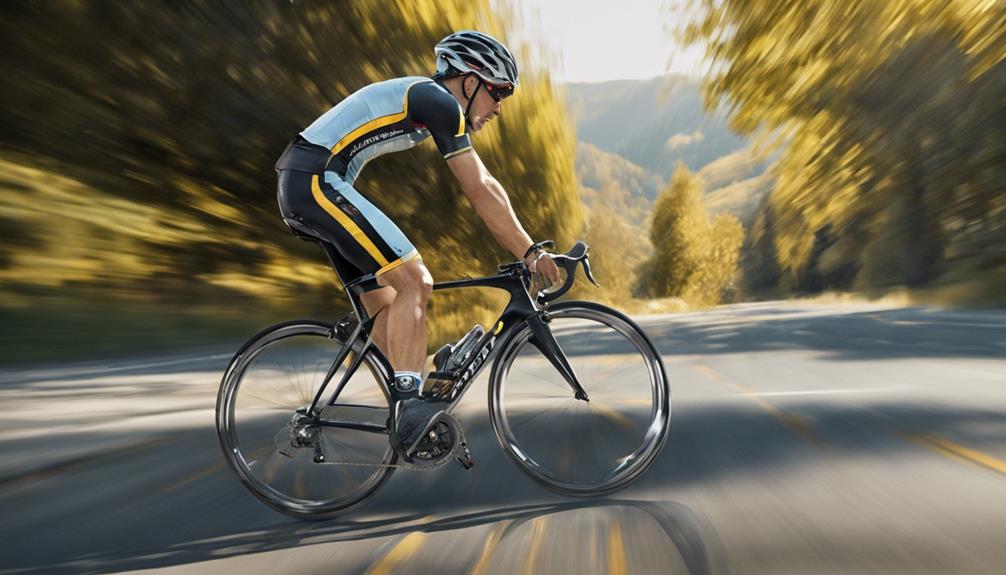
What gear ratios are most suitable for flat road cycling to ensure optimal performance and efficiency? When cycling on flat roads, it's essential to select the right gears to maximize your efficiency and enjoyment. Here are some tips to help you make the best gear selections:
- Choose the Right Crank: Opt for a standard crank if you're a strong rider looking for power on flat terrain, or consider a mid-compact crank for more versatility when encountering varied landscapes.
- Utilize Cassettes with Less Range: Optimal gear selection for flat roads involves using cassettes with a narrower range of gears. This setup allows for seamless transitions between gears, promoting a smoother riding experience.
- Select Appropriate Gear Combinations: Experiment with different gear combinations, including low, middle, and high gears, to find the ones that offer the best balance of comfort and efficiency on flat roads.
Avoiding Common Gear Mistakes
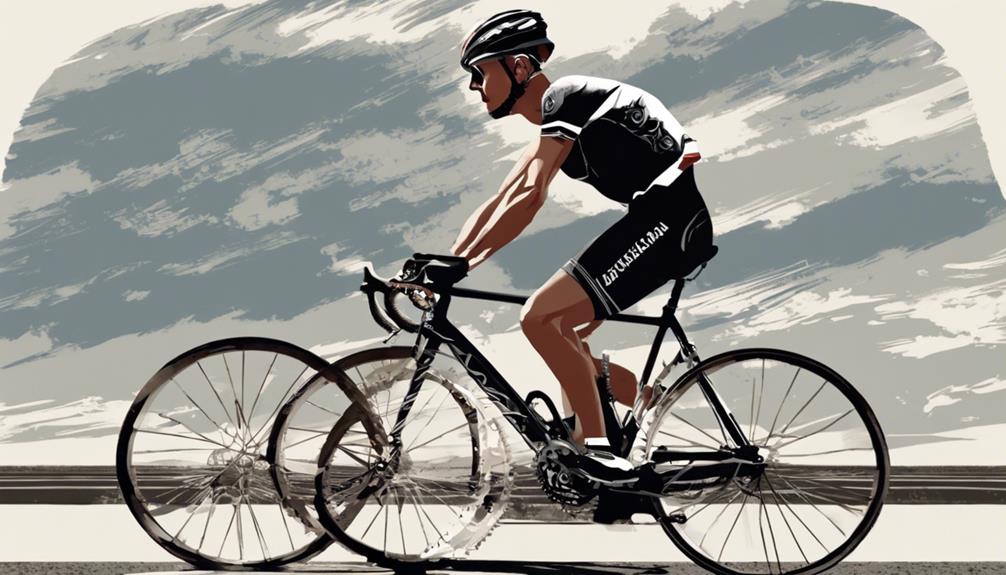
To optimize your performance and prevent strain on flat roads, it's important to avoid common gear mistakes. These include using high gears excessively, maintaining a moderate pace with middle gears, and steering clear of cross-chaining for smoother pedaling.
When cycling on flat terrain, avoiding high gears is crucial to prevent excessive strain on your muscles and joints. Instead, opt for a middle gear to sustain a comfortable pace while conserving energy. Cross-chaining, or using extreme gear combinations, should be avoided to ensure smooth pedaling motion and reduce the risk of gear wear.
Proper gear selection on flat roads is essential for efficiency and reducing fatigue. By utilizing the rear cogs for minor adjustments in gear ratio, you can optimize your cycling experience, enhance comfort, and enjoy a more pleasant ride. Remember, the right gear choice can make a significant difference in your overall performance on flat roads.
Improving Cycling Efficiency on Flats

Improving cycling efficiency on flat terrains requires precise gear selection tailored to the athlete's strength and terrain flexibility, ensuring optimal performance and comfort. When aiming for peak efficiency on flat road conditions, consider the following:
- Optimal Gear Selection: Choose between a standard crank for strong riders or a mid-compact crank for versatility in varied terrains, allowing for better adaptation to flat road conditions.
- Smooth Transitions: Opt for cassettes with narrower gear ratios to facilitate seamless gear changes, promoting smoother transitions and reducing disruptions in cadence on flat surfaces.
- Enhancing Pedaling Efficiency: Experiment with different gear combinations such as low, middle, and high gears to find the optimal balance between effort and speed, maximizing pedaling efficiency for improved cycling performance.
Frequently Asked Questions
What Gear for Flat Road Cycling?
For flat road cycling, we recommend selecting a gear that allows for efficient pedaling without excessive strain. Finding the right balance between resistance and cadence is key to enjoying a smooth and comfortable ride.
What Gear Do You Use to Ride a Flat Bike?
We ride flat roads in a middle gear for smooth pedaling and energy conservation. Choosing the right gear ratio prevents muscle strain and maintains a steady cadence. High gears cover more distance per pedal turn, enhancing performance.
How Do You Use Road Bike Gears Efficiently?
We maximize efficiency by smoothly shifting gears, maintaining cadence on flat roads. Our approach balances speed and power with mid-compact cranks, standard cranks for higher speeds, and narrower range cassettes. Modern drivetrains ensure seamless transitions for a steady ride.
Are Heavier Cyclists Faster on Flat?
We heavier cyclists may have an edge on flat roads thanks to increased momentum and power. The extra weight helps maintain speed and conquer wind resistance. Aerodynamics and power-to-weight ratio also matter, especially in time trials.
Conclusion
In conclusion, mastering bicycle gear use on flat roads is like finding the perfect rhythm in a symphony. Each gear change is a note played with precision, blending seamlessly to create a harmonious cycling experience.
By understanding the mechanics, practicing efficient techniques, and selecting optimal gears, cyclists can pedal with ease and grace. Just as a conductor directs an orchestra, mastering gear use allows us to control our ride with finesse and confidence.
Olivia’s writing is not only informative but also inspiring. She has a knack for telling stories that capture the essence of cycling and the joy it brings to people’s lives. Her writing has been praised by readers and industry experts alike for its clarity, depth, and authenticity.
In addition to her writing, Olivia is also an avid cyclist. She enjoys exploring new trails and routes and has participated in several cycling events and races. Her first-hand experience with cycling gives her a unique perspective on the sport, reflected in her writing.
Overall, Olivia is a talented writer passionate about cycling and dedicated to producing high-quality content for FlatironBike. Her contributions to the magazine have helped make it a go-to source for cycling enthusiasts worldwide.
Beginners Guides
7 Ways a Bicycle Is Useful to Us
Pedal into a world of possibilities with the incredible benefits a bicycle offers – from personal health to environmental impact.

Riding a bicycle is like unlocking a treasure chest of benefits waiting to be discovered. From boosting our physical health to reducing our carbon footprint, a bicycle is a versatile tool that offers more than meets the eye.
Let's explore the seven ways a bicycle can positively impact our lives and society as a whole.
Key Takeaways
- Improves physical health by enhancing fitness levels and strengthening muscles.
- Reduces environmental impact by cutting pollution and promoting sustainability.
- Saves money through cost-effective commuting and minimal maintenance costs.
- Enhances mental well-being by reducing stress, boosting brain function, and fostering social connections.
Health Benefits of Cycling
Cycling offers a myriad of health benefits, reducing the risk of various health conditions and improving overall fitness levels. Engaging in regular cycling serves as an excellent form of exercise that enhances cardiovascular fitness and muscle strength. This aerobic exercise not only aids in weight loss but also lowers the risk of stroke, heart attack, cancer, depression, diabetes, obesity, and arthritis. Just dedicating 2-4 hours per week to cycling can lead to significant health improvements, making it a time-efficient way to stay fit.
Additionally, the mental health benefits of cycling are noteworthy, as it provides a means to replace sedentary time with physical activity, promoting overall well-being. Even individuals with physical limitations can benefit from hand cycling, which offers cardiovascular and aerobic advantages for those with amputations, spinal injuries, or stroke recovery. Cycling truly embodies the essence of holistic health and vitality.
Environmental Friendliness
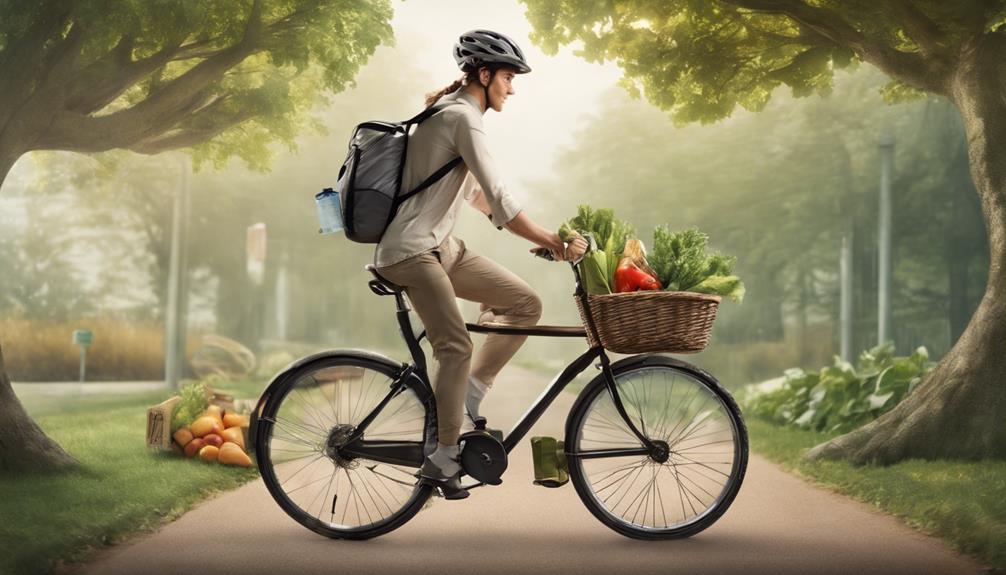
Bicycles, as an eco-friendly mode of transportation, play a crucial role in reducing pollution and promoting environmental sustainability. Riding a bike isn't only environmentally friendly but also offers numerous health benefits. Compared to vehicle passengers, cyclists inhale less pollution, contributing to better overall health. Commuting by bike significantly reduces the transportation carbon footprint by 67%, making it a sustainable choice for those concerned about environmental conservation.
In urban areas, where congestion and emissions are pressing issues, bikes provide a cleaner and healthier transportation option. By choosing to cycle instead of drive, individuals can actively help to reduce emissions and alleviate traffic congestion. Cycling not only benefits the individual rider but also contributes to a cleaner environment for all. Embracing bicycles as a means of transport is a step towards creating a more sustainable and eco-conscious society.
Cost-Effective Transportation Solution

Cycling offers an economic travel option for individuals seeking a budget-friendly commuting choice. By opting for a bicycle, we can enjoy an affordable way to travel that saves us money on fuel, insurance, and parking fees.
The minimal maintenance costs of bicycles compared to cars make them a cost-effective transportation solution for daily commuting needs.
Economic Travel Option
Embracing two-wheeled travel offers a budget-friendly and efficient way to navigate urban landscapes, saving on various transportation expenses. Cycling as an economic travel option not only helps in avoiding traffic congestion and parking expenses but also reduces the overall cost of commuting compared to owning a car. Bicycling serves as a cost-effective mode of transportation, cutting down expenses on fuel, registration, insurance, and maintenance. Furthermore, it promotes physical fitness, eliminating the need for costly gym memberships. By choosing bicycles for transportation, individuals can enjoy the built-in exercise benefits while minimizing travel costs.
| Benefits | Description |
|---|---|
| Cost-Effective | Saves money on fuel, registration, insurance, and maintenance. |
| Traffic Congestion | Helps in avoiding congested roads, leading to faster and more reliable travel. |
| Parking Expenses | Eliminates the need for expensive parking fees in urban areas. |
| Physical Fitness | Promotes health and wellness through regular physical activity. |
| Built-in Exercise Benefits | Provides exercise benefits while commuting, reducing the need for a separate gym membership. |
Budget-Friendly Commuting Choice
Navigating urban landscapes on two wheels presents a budget-friendly and efficient means of transportation, offering significant savings on various commuting expenses. Commuting by bike is a cost-effective option that helps individuals save money on fuel, maintenance, insurance, and registration fees.
Choosing a bicycle for commuting is an economical mode of transport, reducing overall transportation expenses and avoiding the high costs associated with car ownership. Cycling as transportation provides significant savings over time, making it a wise financial decision for those looking to cut down on commuting costs.
Affordable Way to Travel
When considering cost-effective transportation solutions, utilizing bicycles emerges as a practical and economical choice for travel. Cycling is an affordable way to travel, significantly reducing transportation costs compared to owning and maintaining a car. Here are some key points highlighting why cycling is a budget-friendly and practical option for travel:
- Bicycles are a cost-effective mode of transportation, saving money on fuel, registration, insurance, and maintenance.
- Using a bicycle for transportation helps avoid expenses associated with car ownership, making it a budget-friendly option.
- Bicycles provide an economical travel solution, minimizing the financial burden of fuel prices and maintenance fees.
- Choosing a bicycle for transportation is a practical and affordable option that contributes to overall cost savings.
Physical Fitness Improvement
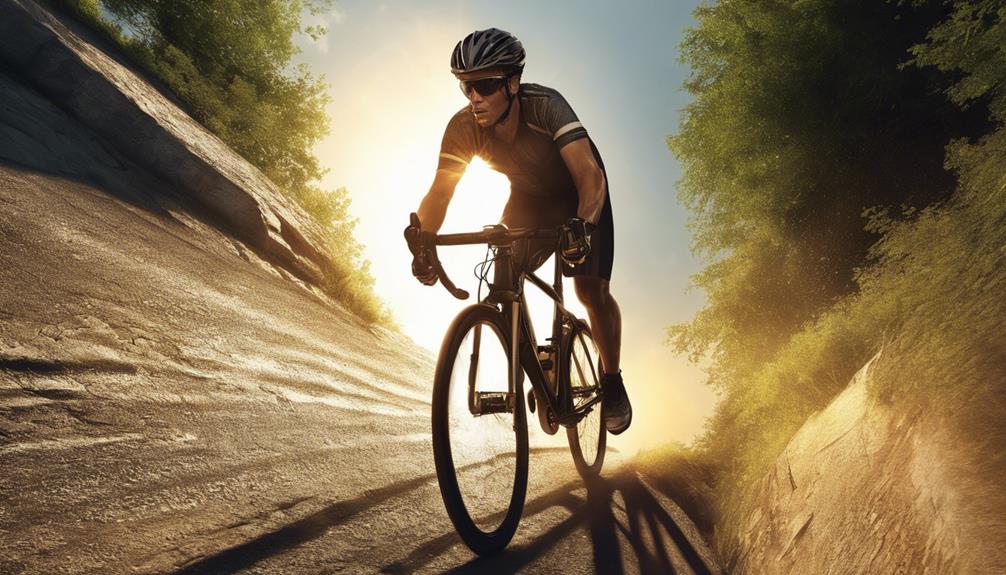
Cycling offers a substantial boost to our physical fitness levels by targeting key muscle groups and enhancing cardiovascular health. It's a low-impact exercise that strengthens the legs and improves balance, coordination, and posture.
Regular cycling sessions can help improve stamina, endurance, and overall cardiovascular function, making it a fantastic workout choice for individuals of all fitness levels.
Health Benefits
Improving physical fitness through cycling offers a range of benefits, including strengthening leg muscles, enhancing balance, posture, and coordination, and targeting key muscle groups such as quads, glutes, hamstrings, and calves.
Cycling is a low-impact exercise option that's gentle on the body and enhances cardiovascular function and overall fitness levels. It provides a time-efficient way to get fit and replace sedentary time with healthy exercise, benefiting individuals of all ages.
Regular cycling strengthens the cardiovascular system, enabling more exercise with less effort, and helps individuals achieve physical activity guidelines effectively. Adults cycling use 10 times more oxygen than sitting, promoting respiratory health by making the lungs work harder and delivering more oxygen where it's needed.
Cardiovascular Workout
Enhancing cardiovascular fitness through regular cycling contributes significantly to overall physical well-being and health. Cycling provides an effective cardiovascular workout, strengthening the heart, improving blood circulation, and lowering blood pressure.
By increasing heart rate, cycling helps improve cardiovascular fitness, reduce the risk of heart disease and stroke, and enhance endurance. This low-impact exercise is gentle on the joints while still offering a challenging workout.
Consistent cycling sessions lead to improved heart health, increased stamina, and enhanced physical fitness levels. Incorporating cycling into a routine not only benefits the heart but also contributes to overall well-being by boosting fitness and lowering the risks associated with a sedentary lifestyle.
Stress Reduction and Mental Wellbeing

Stress levels can be effectively reduced and mental well-being promoted through the scientifically proven benefits of cycling. Cycling isn't just a physical activity; it also has significant positive effects on mental health. Here are some key ways cycling contributes to stress reduction and mental well-being:
- Cycling releases endorphins, known as 'feel-good' hormones, which help reduce stress, anxiety, and depression.
- Regular cycling boosts brain function, enhances cognitive abilities, and improves overall mental health.
- Engaging in cycling stimulates blood flow to the brain, aiding in relaxation, focus, and concentration.
- Studies show that cycling is as effective as medication in reducing stress and promoting a positive mindset.
Community Connection and Social Interaction

Cycling not only promotes physical health but also nurtures a sense of community and encourages social interactions among individuals with shared interests. Riding a bicycle creates opportunities for community connection and social engagement through various avenues such as cycling clubs, group rides, and cycling events. Cyclists often come together to share their passion for biking, meet new people, make friends, and form lasting bonds.
| Community Connection | Social Interaction |
|---|---|
| Cycling clubs provide a platform for cyclists to engage with like-minded individuals. | Group rides offer a chance to connect with others while enjoying the thrill of cycling. |
| Community bike events, like charity rides or cycling festivals, foster an inclusive environment for cyclists. | Participating in cycling events allows cyclists to meet new people and form friendships based on their shared love for biking. |
In these settings, individuals find a supportive community that not only values their shared interest in cycling but also encourages social connections and interactions.
Sustainable and Green Lifestyle Choice

Choosing to ride a bicycle aligns with sustainable living practices and reduces our reliance on non-renewable resources. Bicycles are a sustainable transportation choice, producing zero emissions and reducing the carbon footprint. Opting for cycling helps create a greener environment by decreasing air pollution and harmful emissions. Cycling promotes a green lifestyle by minimizing the use of fossil fuels and contributing to cleaner air.
It's an eco-friendly mode of transport that supports the preservation of natural resources and aligns with sustainable living practices. By choosing bicycles over cars, we actively participate in reducing our carbon footprint and promoting green transportation. Embracing cycling as a sustainable and green lifestyle choice not only benefits our health but also plays a significant role in preserving the environment for future generations.
Let's pedal towards a more sustainable future together.
Frequently Asked Questions
What Can Bicycles Be Used For?
Bicycles can be used for commuting to work, school, or other destinations, reducing reliance on cars and public transportation. They are ideal for recreational purposes such as cycling tours, exploring nature trails, or participating in cycling events.
How Does the Bicycle Help Society?
Cycling weaves our urban tapestry with threads of health, community, and sustainability. Bicycles untangle traffic knots, paint green strokes on carbon clouds, and pedal us into a brighter, closer-knit future.
How Was the Bicycle Important?
The bicycle was crucial throughout history, revolutionizing transportation, empowering women, boosting economies, and promoting public health. Its impact continues to be felt worldwide, providing reliable transport and fostering physical activity, making it a truly enduring invention.
How Do Bikes Help the Environment?
Cycling, like a green breeze, helps the environment by reducing carbon emissions and air pollution. Bicycles are a sustainable transportation choice, cutting down our carbon footprint significantly compared to driving, contributing to cleaner air quality.
Conclusion
In conclusion, cycling offers a multitude of benefits for our health, the environment, and our wallets.
Did you know that cycling just 20 miles a week can reduce the risk of heart disease by 50%?
With its ability to improve physical fitness, mental well-being, and community connections, biking is truly a valuable and enjoyable way to stay healthy and happy.
So grab your helmet and hit the road for a sustainable and rewarding lifestyle choice!
Olivia’s writing is not only informative but also inspiring. She has a knack for telling stories that capture the essence of cycling and the joy it brings to people’s lives. Her writing has been praised by readers and industry experts alike for its clarity, depth, and authenticity.
In addition to her writing, Olivia is also an avid cyclist. She enjoys exploring new trails and routes and has participated in several cycling events and races. Her first-hand experience with cycling gives her a unique perspective on the sport, reflected in her writing.
Overall, Olivia is a talented writer passionate about cycling and dedicated to producing high-quality content for FlatironBike. Her contributions to the magazine have helped make it a go-to source for cycling enthusiasts worldwide.
Beginners Guides
What Are the Basics of How a Bicycle Freewheel Works?
Leveraging intricate mechanisms, bicycle freewheels allow wheels to spin freely—discover the fascinating basics and functions behind this essential component.

When we hop on our bicycles, we often take for granted the intricate workings of the freewheel in the rear hub. Did you know that the freewheel plays a vital role in allowing the wheel to rotate independently of the pedals?
Understanding the mechanisms behind how a bicycle freewheel operates can provide valuable insight into the smooth functioning of this essential component. Let's explore the inner workings of different types of freewheels and uncover the basics of their functionality to gain a deeper appreciation for this often overlooked yet crucial part of our bikes.
Key Takeaways
- Pawls and ratchets enable torque transmission and wheel movement.
- Ratchet and pawl mechanism ensures smooth power transfer and rider flexibility.
- Star ratchet freewheels offer robust construction and reliability on challenging terrains.
- Roller freewheels use ball bearing design for durability and smooth operation.
Components of a Bicycle Freewheel
In a bicycle freewheel, the components responsible for transmitting torque and facilitating forward pedaling are the pawls and ratchets. The ratchet and pawl system in the freewheel is integral to its function.
The pawls, small spring-loaded components, engage with the ratchet's teeth to allow the wheel to turn when the pedals are in use. This interaction forms the basis of the drive system, enabling the transfer of power from the rider's pedaling to the wheel.
The star ratchet design within the freewheel ensures that the pedals remain stationary when the wheel is spinning freely, preventing any unwanted backward rotation. When coasting or not pedaling, the pawls disengage from the ratchet, allowing the wheel to rotate independently without resistance.
This intricate mechanism of pawls and ratchets in the freewheel guarantees a smooth and efficient forward motion while offering the rider the freedom to pedal without constraint.
Ratchet and Pawl Mechanism Explained

Exploring the inner workings of a bicycle freewheel reveals the intricate and efficient system known as the ratchet and pawl mechanism. This mechanism plays a crucial role in enabling torque transmission and facilitating the forward movement of the bicycle.
Here's a breakdown of its key components:
- Ratchet and Pawl Interaction: The pawls engage with the teeth on the ratchet, allowing the wheel to move forward when the pedals are in motion.
- Disengagement for Free Movement: When the pedals are reversed, the pawls disengage from the ratchet, enabling free movement without propulsion.
- Spring Mechanism for Torque Transmission: A spring mechanism within the system ensures that the pawls engage effectively with the ratchet to transmit torque seamlessly.
- Audible Click Feature: The characteristic click sound heard when reversing pedals signifies the engagement and disengagement of the pawls with the ratchet.
This precise and reliable design ensures that the bicycle freewheel operates smoothly, providing efficient power transfer while maintaining the flexibility and freedom desired by cyclists.
Understanding Star Ratchet Freewheels

Amid the realm of bicycle freewheel mechanisms, star ratchet freewheels stand out for their robust construction and enhanced durability. Consisting of two toothed discs with slanted teeth pressed together by a spring during pedaling, these freewheels excel in demanding riding conditions like freeride and downhill.
When idling, the toothed discs in star ratchet freewheels move against each other, creating a characteristic noise that provides riders with distinct auditory feedback. This noise is a result of the discs moving against each other, signifying the reliability and durability of this freewheel mechanism.
The robust nature of star ratchet freewheels makes them a preferred choice for riders tackling challenging terrains, especially when going downhill. The enhanced durability of these freewheels ensures that riders can trust their rear wheel's performance even in the most demanding situations, offering a sense of freedom and confidence while riding.
Inner Workings of Roller Freewheels

Utilizing pinch rollers that are pressed against the hub during pedaling, roller freewheels propel the bicycle forward with efficiency and minimal noise. The inner workings of roller freewheels involve a sophisticated design that ensures seamless functionality.
Here's a closer look at how roller freewheels operate:
- Pinch Roller Mechanism: Pinch rollers are key components that make direct contact with the rear sprocket, transferring power efficiently during pedaling.
- Guide Tracks: These rollers move freely within guide tracks when coasting, resulting in a noiseless riding experience.
- Ball Bearing Design: Similar to ball bearings, roller freewheels are designed for smooth and quiet operation, enhancing the overall riding experience.
- Durability and Reliability: Roller freewheels are renowned for their durability and long service life, making them a dependable choice for riders seeking a silent ride.
The meticulous engineering behind roller freewheels ensures smooth engagement under load and quiet operation while coasting, offering riders the freedom to enjoy a peaceful cycling experience.
Functionality of Sprag Clutch Freewheels
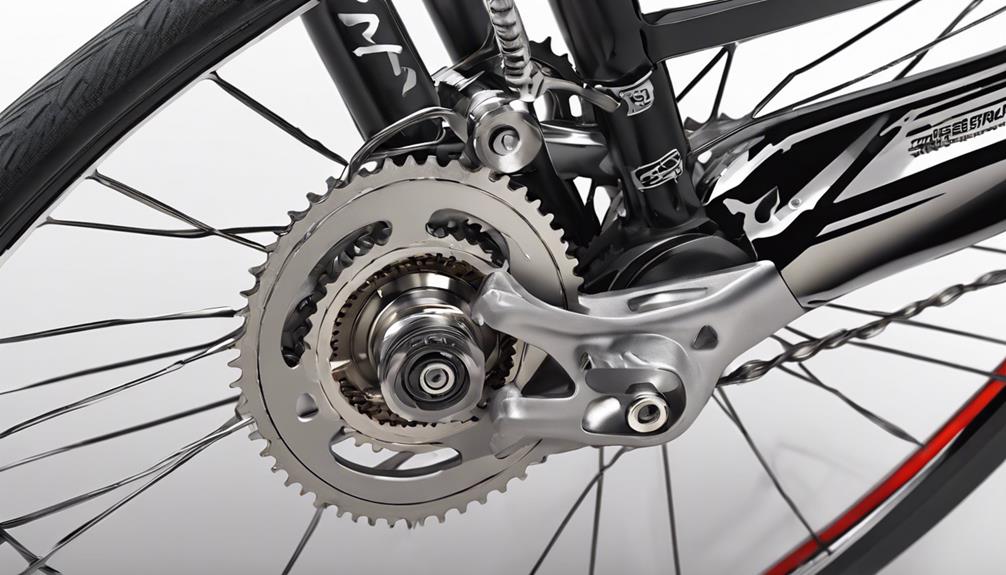
Sprag clutch freewheels employ sprags to facilitate torque transmission within bicycles, ensuring efficient power transfer. When the cyclist stops pedaling, the sprags disengage, allowing the wheel to spin freely without moving the pedals. The design of sprag clutch freewheels enables smooth engagement and disengagement, leading to efficient power transfer when pedaling resumes. The instant engagement of the sprags ensures quick and responsive power delivery, enhancing the overall riding experience.
Due to their simple yet effective design, sprag clutch freewheels require minimal maintenance. Cyclists can enjoy reliable performance in various riding conditions without the need for frequent adjustments or repairs. The durability and functionality of sprag clutch mechanisms make them a popular choice among cyclists seeking consistent and hassle-free operation. Whether navigating city streets or tackling rugged terrains, sprag clutch freewheels provide the necessary torque transmission for a smooth and enjoyable ride.
Frequently Asked Questions
How Does a Bicycle Freewheel Work?
We know how a bicycle freewheel works. It allows pedals to rotate independently from the rear wheel, ensuring smooth coasting. The mechanism engages during forward pedaling and disengages when coasting or backpedaling, playing a vital role in efficient cycling.
What Is the Principle of Freewheel?
Freewheeling is akin to a river flowing, allowing us to move forward effortlessly. The principle of a freewheel is to enable coasting by disconnecting pedals from the wheel, granting us the freedom to control our speed effortlessly.
What Is the Free Wheeling Technique?
Freewheeling technique on a bicycle involves coasting without pedaling, allowing riders to conserve energy and maintain momentum. It's crucial for controlling speed and balance during descents, enhancing the overall riding experience.
What Is the Difference Between a Freewheel and a Freehub?
We differentiate between a freewheel and a freehub by their attachment methods to the hub and compatibility with sprocket configurations. Freewheels thread onto hubs with a lockring, while freehubs use a splined interface for cassettes, offering more versatility.
Conclusion
In conclusion, the bicycle freewheel is a marvel of engineering, allowing for seamless transmission of power while enabling the wheel to rotate independently of the pedals.
Its intricate mechanisms, such as the ratchet and pawl, star ratchet, roller, and sprag clutch, work in harmony to provide cyclists with a smooth and efficient riding experience.
The freewheel is like a symphony of precision, orchestrating the dance between pedal power and wheel rotation with unparalleled grace and finesse.
Olivia’s writing is not only informative but also inspiring. She has a knack for telling stories that capture the essence of cycling and the joy it brings to people’s lives. Her writing has been praised by readers and industry experts alike for its clarity, depth, and authenticity.
In addition to her writing, Olivia is also an avid cyclist. She enjoys exploring new trails and routes and has participated in several cycling events and races. Her first-hand experience with cycling gives her a unique perspective on the sport, reflected in her writing.
Overall, Olivia is a talented writer passionate about cycling and dedicated to producing high-quality content for FlatironBike. Her contributions to the magazine have helped make it a go-to source for cycling enthusiasts worldwide.
-

 Vetted5 months ago
Vetted5 months ago12 Best Men's Cycling Bib Shorts for Comfort and Performance – Reviewed & Rated
-

 Electric Bike3 weeks ago
Electric Bike3 weeks agoHow To Turn Your Bike Into An Electric Generator
-

 Vetted4 months ago
Vetted4 months ago15 Best Fixed Gear Bikes for Urban Commuting and Stylish Riding
-

 Bike4 months ago
Bike4 months agoAdvantages and Disadvantages of a Carbon Fiber Bike Frame
-

 Vetted5 months ago
Vetted5 months ago15 Best Cycling Jerseys for Men to Elevate Your Riding Game
-

 Vetted5 months ago
Vetted5 months ago15 Best Cycling Gloves for Comfort and Performance – Ultimate Guide for Cyclists
-

 Vetted4 months ago
Vetted4 months ago15 Best Cruiser Bikes to Hit the Road in Style
-

 Vetted4 months ago
Vetted4 months ago15 Best Comfort Bikes for a Smooth and Enjoyable Ride







